The clowns encouraged participants to reconnect with uninhibited curiosity of children, creating a space where everyone felt comfortable engaging.
In Mexico, attending a children’s party almost always includes some form of entertainment, either before or after the meal. These performances can range from a superhero show featuring the birthday child’s favorite character to a botarga (costume) act or even a clown show. These activities transform the party into a lively, fun-filled atmosphere with plenty of laughter. While primarily aimed at children, they often engage guests of all ages. However, as children grow older, such playful performances tend to fade away.
Despite Mexican traditions often incorporating music, dance, and theatrical performances, there are certain events where these artistic elements are absent. Formal presentations of project reports, government meetings, or workplace presentations are typical examples. The presentation of final project results is no exception, as it is usually conducted in a serious and formal setting.
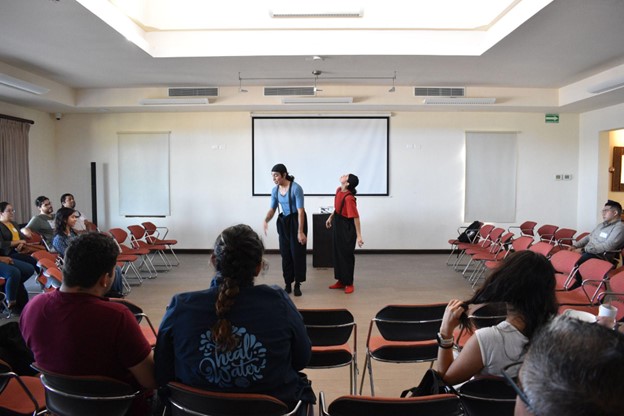
But, in November 2024, something different happened at a science meeting in La Paz. During the presentation of two key initiatives―STEW-MAP La Paz: Connecting the Community with Nature (2022-2024) and the Action Plan for the Integral Management of the La Paz Watershed and Aquifer (PAMIC)―we chose to break the mold.
STEW-MAP is a participatory mapping project that documents how community organizations contribute to taking care of the environment. PAMIC, on the other hand, is a scientifically-based collaborative plan aimed at preserving the hydrological services of the La Paz watershed through actionable interventions. For this presentation, we invited the theatrical clown group, Pocus Locus, to bring a creative twist to the event. The idea was to create a relaxed, safe, and engaging atmosphere, transforming what could have been perceived as another tedious, three-hour workshop into an enjoyable and memorable experience.
The Niparajá Natural History Society, Pocus Locus, and the U.S. Forest Service International Programs in Mexico decided to use water as the central theme connecting the two projects, the organizers, and the attendees. Water became the “special guest” and was featured as part of the icebreaker activities led by the clowns.
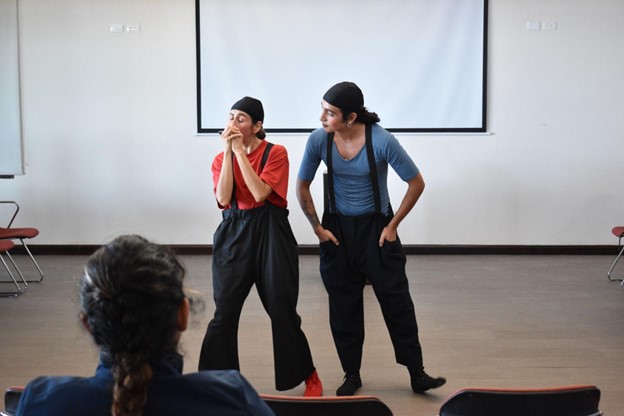
At the start of the workshop, the clowns presented water as a vital element present within all of us. As attendees arrived, settled into their seats, and enjoyed a welcome breakfast, the clowns, dressed as a drop of water, wandered playfully among the crowd. This “water drop” moved between seated and standing guests, sparking confusion among some who wondered if they were in the right place.
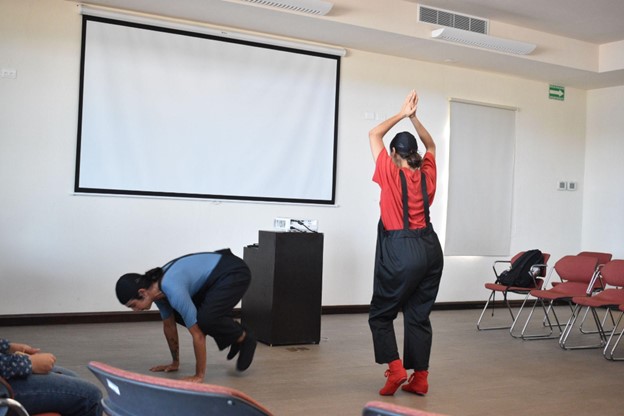
While some guests laughed, others paid little attention and continued sipping their coffee. After a few minutes, the “water drop” disappeared, and the clowns staged a short skit about the importance of water.
This performance kept early attendees entertained as others gradually arrived―a practical strategy, given that punctuality is not a strong suit in Mexico.
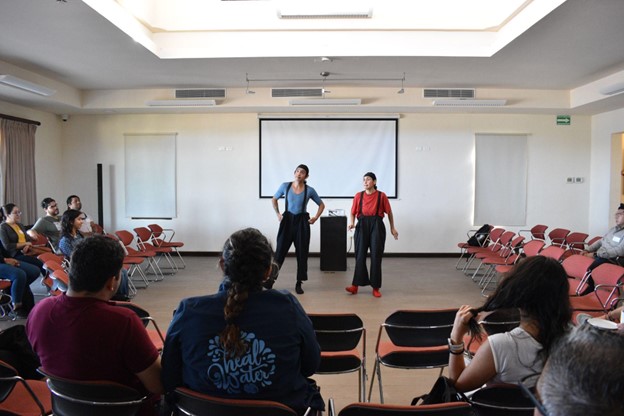
Once most guests had arrived, the clowns actively engaged the audience by asking questions and sharing fun facts about water. For example, they explained how water travels through a plant and through the human body, highlighting its vital role in sustaining life. They also shared a curious fact about how our eyes evaporate water when exposed to the sun, a playful reminder of how interconnected we are with this essential good. Additionally, the clowns pointed out that over the 60% of our brain and blood is composed of water, emphasizing its importance not only in nature but within ourselves. Then, the “party” began, with the clowns encouraging attendees to move their arms, legs, and bodies, simulating the sensation of water flowing through them.
Although the activities were unconventional for this type of event, participants followed the instructions while laughing among themselves. Afterward, the clowns introduced the idea of creating a “human wave”.
This collective gesture, commonly seen at sports events or concerts, amused the attendees, as it was highly uncharacteristic for a formal setting. Nevertheless, they followed the instructions: the first section of the audience stood up, raised their arms, and passed the movement along to their neighbors. Although hesitant at first, the group quickly became more coordinated, and by the final attempt, the wave was executed with enthusiasm and energy.
This icebreaker fostered cooperation and camaraderie, setting a positive tone for the subsequent presentations.
The highlight of the workshop was a “snooping” act performed by the clowns during the formal presentations of STEW-MAP and PAMIC. They asked silly or seemingly naive questions, underscoring the idea that no question is too simple to ask―and if it were, it was their role to ask it. At one point, the clowns humorously proclaimed, “What makes it different is that it’s not the same” a playful yet thought-provoking statement that captured the unique essence of the workshop. This approach helped bridge the gap between different types of expertise about nature and the environment. Each attendee brought their own perspective, experience, and area of knowledge to the workshop, but adults often hesitate to ask questions outside their field of expertise, fearing they might seem uninformed.
By contrast, as children, we are naturally curious and unafraid to ask “obvious” questions. The clowns’ act encouraged participants to reconnect with that uninhibited curiosity, creating a space where everyone felt comfortable engaging, regardless of their background or level of expertise.
By the end of the event, every attendee left with a smile, surprised and delighted by the unconventional format. Much like a children’s party, the performance by Pocus Locus brought joy and unity to the group. The goal of weaving community bonds through creativity and humor was achieved, encouraging attendees to build networks centered on environmental care in La Paz. We hope that more organizations in Mexico and beyond will embrace the integration of a performance art into their events, as it can inspire collective action and foster deeper connections with nature.
Arantxa Zamora
Mexico City
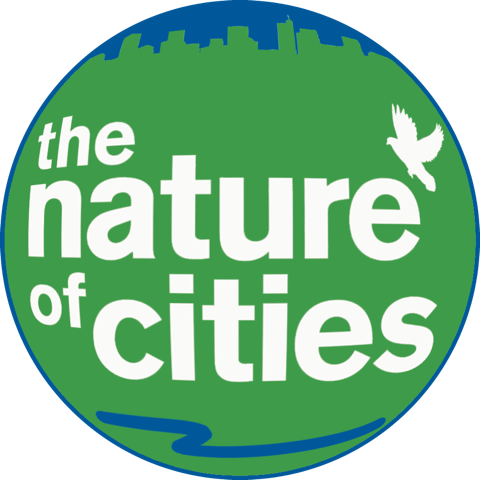

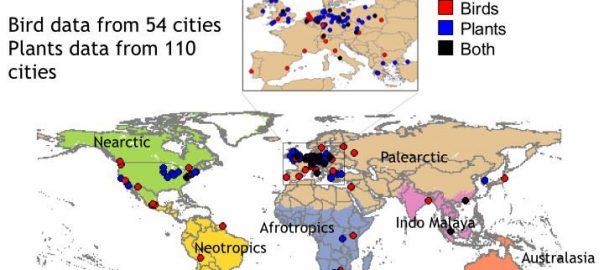
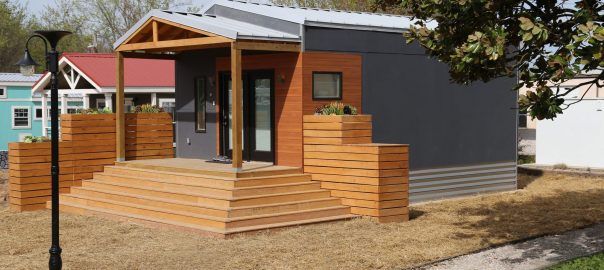
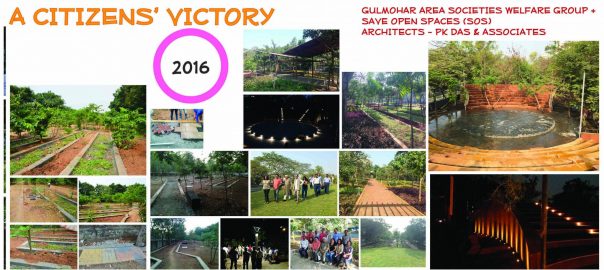

Leave a Reply